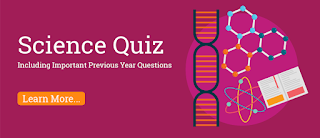Biology Quiz for SSC CHSL 2018
Q1. The transfer of minerals from topsoil to subsoil through soil water is called?
पानी के माध्यम से ऊपरी मिट्टी से निचली मिट्टी में खनिज पदार्थों के हस्तांतरण को किस नाम से जाना जाता है?
(a) Percolation (रिसना)
(b) Conduction (संचालन)
(c) Leaching (निकासी)
(d) Transpiration (स्वेद)
Q2. Morphology of Chromosomes can be best studied at ______
क्रोमोजोमों का आकृति विज्ञान का सबसे अच्छा अध्ययन______ में किया जा सकता है.
(a) Interphase (इंटरफेस)
(b) Prophase (प्रोफेस)
(c) Metaphase (मेटाफ़ेस)
(d) Zygotene (ज़िगोटेन)
Q3. Polio is caused by
पोलियो का कारण होता है:
(a) Bacteria (बैक्टीरिया)
(b) Virus (वायरस)
(c) Fungus (कवक)
(d) Protozoa ( प्रोटोजोआ)
Q4. The pacemaker of heart is—
दिल का पेसमेकर होता है
(a) Bundle of His (बंडल ऑफ़ हिज़)
(b) S A node (एस ए नोड)
(c) AV node (ए वी नोड)
(d) Purkinje fibres (पर्किंज फाइबर)
Q5.Which organ gets affected in Weil's disease?
आईविल रोग में कौन सा अंग प्रभावित हो जाता है?
(a) Liver (जिगर)
(b) Lung (फेफड़े)
(c) Heart (दिल)
(d) Kidney (गुर्दा)
Q6.The main protein found in milk is ____________
दूध में पाया जाने वाला मुख्य प्रोटीन ______ है
(a) Albumin (अल्बुमिन)
(b) Globulin (ग्लोबुलिन)
(c) Globin (ग्लोबिन)
(d) Casein (कैसिइन)
Q7.The waste management technique that involves the use of microorganisms to remove or neutralize pollutants from contaminated site is called—
कचरा प्रबंधन तकनीक जिसमें सूक्ष्मजीवों का उपयोग शामिल है, दूषित स्थानों से प्रदूषकों को निकालने या बेअसर करने के लिए किया जाता है उसे कहा जाता है-
(a) Bio sensor (जैव सेंसर)
(b) Bio magnification (जैव आवर्धन)
(c) Bio remediation (जैव उपचार)
(d) Bio concentration (जैव एकाग्रता)
Q8.Haematopoiesis take place in ___________
हेमाटोपोईज ___________ में होते हैं.
(a) Lungs (फेफड़े)
(b) Pancreas (अग्न्याशय)
(c) Liver (जिगर)
(d) Bone marrow (अस्थि मज्जा)
Q9.Ultraviolet radiation in the stratosphere is absorbed by—
स्ट्रैटोस्फियर में पराबैंगनी विकिरण अवशोषित होता है-
(a) SO2
(b) Ozone (ओजोन)
(c) Oxygen (ऑक्सीजन)
(d) Argon (आर्गन)
Q10.Pellagra and Scurvy are caused by which pair of vitamin deficiency respectively _______
चर्मग्राह और रक्तस्राव रोग क्रमशः ____युग्म की कमी के कारण होता है.
(a) Vitamin C and Vitamin D (विटामिन सी और विटामिन डी)
(b) Vitamin B-12 and Vitamin C (विटामिन बी -12 और विटामिन सी)
(c) Vitamin C and Vitamin A (विटामिन सी और विटामिन ए)
(d) Vitamin A and Vitamin B-12 (विटामिन ए और विटामिन बी -12)
Q11. Which of the following group of plant produce naked seed—
निम्नलिखित में से कौन से पौधे का समूह नग्न बीज का उत्पादन करता है -
(a) Angiosperm (एंजियोस्पर्म)
(b) Gymnosperm (जिम्नोस्पर्म)
(c) Pteridophytes (पटरिडोफाइट्स)
(d) Bryophytes (ब्रियोफाइट्स)
Q12. Leptospirosis is a disease caused by—
लेप्टोस्पिरोसिस एक बीमारी है जो ___के कारण होती है.
(a) Virus (वायरस)
(b) Fungus (कवक)
(c) Protozoa (प्रोटोजोआ)
(d) None (कोई नहीं)
Q13. Hepatitis affects which organ of the human body?
हेपेटाइटिस मानव शरीर का अंगों में से किसे प्रभावित करता है?
(a) Liver (जिगर)
(b) Pancreas (अग्न्याशय)
(c) Spleen (प्लीहा)
(d) Small intestine (छोटी आंत)
Q14. Increased RBC's in the blood leads to a condition called __________ .
रक्त में बढ़ा हुआ आरबीसी से एक की स्थिति उत्पन्न होती है जिसे कहा जाता है?
(a) Anemia (एनीमिया)
(b) Haemophilia (हीमोफिलिया)
(c) Polycythemia (पॉलीसिथेमिया)
(d) Leukaemia (ल्यूकेमिया)
Q15. Root cap is derived from—
रूट कैप ____से प्राप्त होता है.
(a) Dermatogen (डर्माटोजेन)
(b) Calyptrogen (कैलेप्ट्रोजन)
(c) Protoderm (प्रोटोडर्म)
(d) Histogen (हिस्टोजेन)
Categories
- Ancient History Quiz
- Medieval History Quiz
- Modern History Quiz
- Indian Polity Quiz
- Physical Geography Quiz
- World Geography Quiz
- Geography of India Quiz
- Indian Economy Quiz
- Indian Arts and Culture Quiz
- Physics Quiz
- Chemistry Quiz
- Biology Quiz
- Computer Basics Quiz
- Sports Quiz
- Samanya Hindi Quiz
- Miscellaneous Quiz
Tags
SSC Quiz Study Notes The Hindu Vocab
